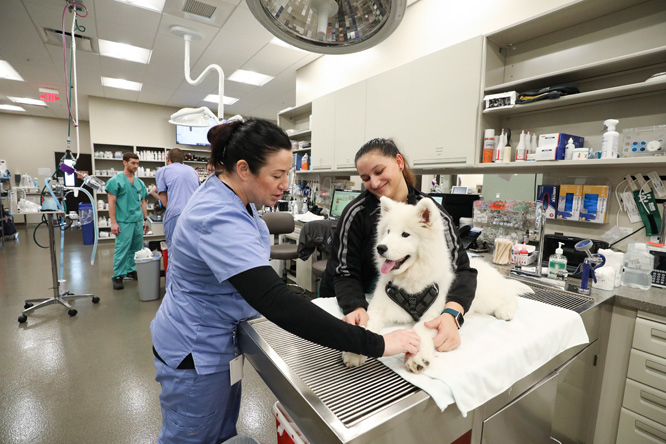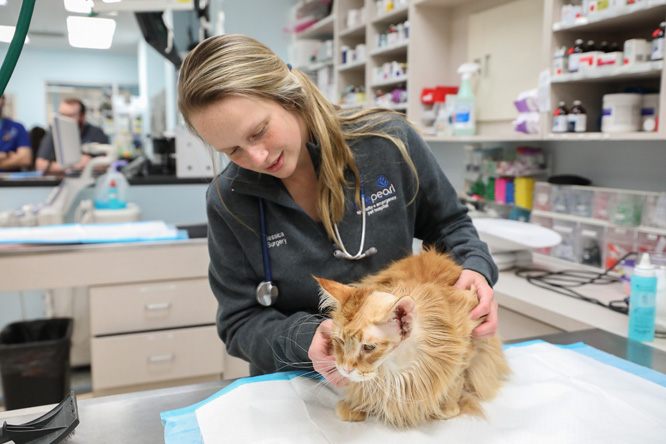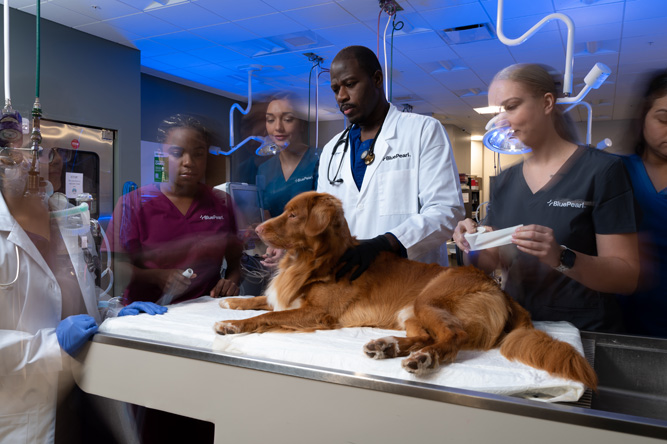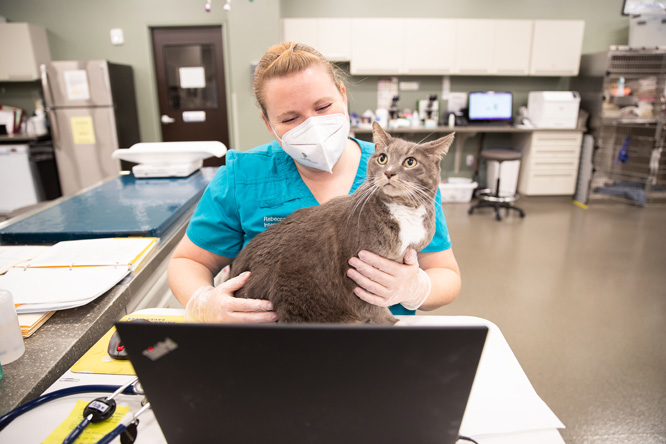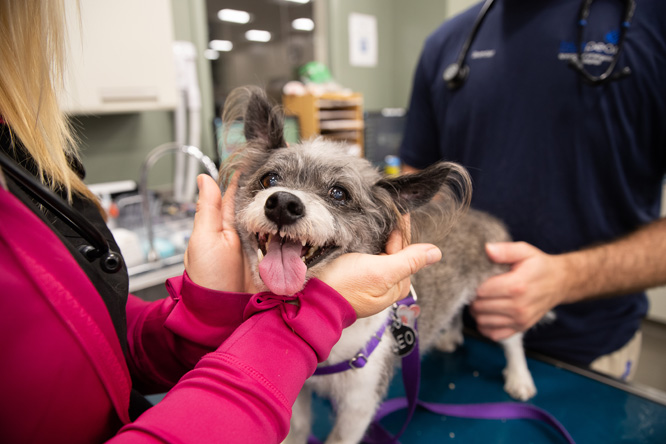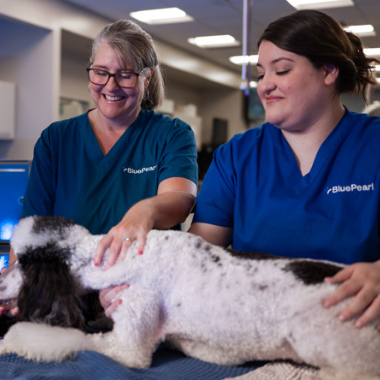Pet emergency medicine by BluePearl.
Pet emergencies can be scary – we’re here to help you handle them.
We understand that seeing your pet sick, hurt or in distress can be stressful – especially if you don’t know what’s wrong. Fortunately, our experienced ER clinicians are prepared to take action and help.

Common pet emergencies.
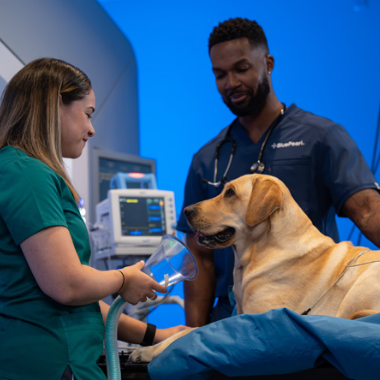
Acting quickly in an emergency may save your pet’s life.
If your pet is experiencing an emergency, you’ll have an entire veterinary team helping them so you can get back to what matters most – spending precious moments together.
- Accidents, injuries and trauma (hit-by-car, animal attacks, etc.)
- Bleeding
- Bloat (gastric dilatation volvulus, or GDV)
- Collapse or unresponsiveness
- Complications from chronic diseases
- Difficulty breathing
- Straining to urinate
- Ingestion of medications, poisons or objects
- Seizures
- Vomiting and diarrhea
Our emergency team.
Experience makes all the difference.
Our emergency team is made up of veterinarians, vet technicians and assistants, and support staff with rigorous training and experience in specialty medicine. The team works hand in hand to provide the comprehensive, compassionate care your pet needs and deserves. Because we’re a multidisciplinary hospital, the team can consult the expertise of other specialty departments, too.
Emily Ansel
DVMDr. Emily Ansel is excited by all aspects of emergency medicine. She especially enjoys cases involving internal medicine, toxins, wound care and reproduction.
- Internship, Small Animal & Surgery, Virginia Polytechnic Institute and State University, Blacksburg
- Doctor of Veterinary Medicine, North Carolina State University, Raleigh NC
- Bachelor of Science, Biology, Duke University, Durham
Outside of work, Dr. Ansel enjoys reading, exploring the outdoors and spending time with her family. She has a special interest in purebred dogs and has participated in various dog sports with her Vizsla and Brittany dogs.
Katherine Blincoe
DVMDr. Katherine Blincoe brings a positive and bright attitude to work. She is particularly interested in emergency procedures including laceration repairs, thoracic limb amputations, foreign body removal, enucleations, and gastrointestinal (GI) surgery. She is also passionate about feline urethral obstruction and congestive heart failure cases.
- Internship, Small Animal Medicine & Surgery, VCA California Veterinary Specialists, Carlsbad
- Doctor of Veterinary Medicine, Midwestern University, Glendale AZ
- Bachelor of Science, Biology, Christopher Newport University, Newport News VA
Dr. Blincoe and her husband have a Labrador retriever, Wendy, and two cats, a black-and-white polydactyl, Rorschach, and an orange tabby, Shakespeare. She enjoys cooking, visiting with family, playing games, and spending time outside walking her dogs or drinking tea on her porch.
Lauren Block
DVMDr. Lauren Block’s favorite cases are urgent emergencies. She loves stabilizing patients and seeing her efforts take effect. Her professional interests include urethral obstruction, pericardiocentesis, and hemoabdomen.
- Internship, Small Animal Medicine & Surgery, VCA South Shore Animal Hospital, Weymouth MA
- Clinical Rotation, North Carolina State University, Raleigh
- Doctor of Veterinary Medicine, St. George’s University, Granada
- Bachelor of Science, Animal Science, University of Massachusetts, Amherst
Dr. Block lives with her husband, young daughter and black Lab, Lacey. She enjoys exercising, staying active and traveling.
Kelly Catanzaro
PhD, DVMDr. Kelly Catanzaro is interested in treating feline upper respiratory diseases as there are a myriad of potential treatments and she finds it gratifying to identify which ones work best for each patient. Her interests also include Lyme disease and other tick-borne diseases as well as infectious diseases, which were the subject of her PhD research.
- Internship, Small Animal Medicine & Surgery, MedVet Akron, OH
- Doctor of Veterinary Medicine, Virginia Polytechnic Institute and State University, Blacksburg
- Doctor of Philosophy, Virginia Polytechnic Institute and State University, Blacksburg
- Bachelor of Science, Biology, Animal Sciences, University of Maryland, College Park
Dr. Catanzaro and her husband have many pets, but her oldest (and most special) is her tortoiseshell cat named Hampster who she’s had since college. In her free time, Dr. Catanzaro enjoys hiking, being outdoors and renovating every room in her house.
Nick de Silvia
DVMDr. Nick de Silvia’s professional interests include emergent endocrine diseases, autoimmune disorders and acute toxicities.
- Internship, Small Animal Medicine & Surgery, Veterinary Specialty Hospital of the Carolinas, Cary NC
- Clinical Rotation, Auburn University, AL
- Doctor of Veterinary Medicine, St. George’s University, Grenada
- Bachelor of Science, Queen’s College, Barbados
Dr. de Silvia lives with his wife, who is also a veterinarian, their two children, rescue mutt and two cats. Outside of work, he likes making homemade pasta and bread, exploring new places and playing pickleball.
Isel Del Valle
DVM, CVAAs an experienced emergency clinician, Dr. Isel Del Valle is particularly interested in Eastern medicine, acupuncture, stabilization of septic patients, sports medicine, and rehabilitation.
- Certified Veterinary Acupuncturist, Chi Institute, Reddick, FL
- Internship, Small Animal Medicine & Surgery, Regional Veterinary Referral Center, Springfield, VA
- Doctor of Veterinary Medicine, North Carolina State University, Raleigh
- Bachelor of Science, Biological Anthropology, Duke University, Durham, NC
- Bachelor of Science, Biology, Duke University, Durham, NC
Dr. Del Valle is passionate about travel, gourmet cooking, dressage, gardening, family time, and Duke University sports. She has a horse, a dog and a cat.
Tara Enzweiler
VMDDr. Tara Enzweiler appreciates the wide variety of cases, challenges, and fast pace of emergency medicine.
- Internship, Small Animal Medicine & Surgery, Veterinary Specialty Hospital of the Carolinas, Cary NC
- Doctor of Veterinary Medicine, University of Pennsylvania, Philadelphia
- Bachelor of Science, Science-Business, University of Notre Dame, IN
Dr. Enzweiler is an avid fan of Notre Dame Athletics. She enjoys spending time visiting North Carolina’s beautiful beaches, staying active, playing sports, and experimenting with new recipes in the kitchen.
Jennifer Knutzen
DVM- Internship, Small Animal Medicine & Surgery, Veterinary Specialty Hospital of the Carolinas, Raleigh-Durham, NC
- Doctor of Veterinary Medicine, Washington State University, Pullman
- Bachelor of Science, Ecology and Evolutionary Biology, Mathematics, University of Colorado, Boulder
Sarah Leigh
DVMA highly experienced clinician, Dr. Sarah Leigh is passionate about integrated, collaborative medicine. She thrives in the fast-paced ER environment and enjoys treating and managing complex cases.
- Internship, Small Animal Medicine & Surgery, Florida Veterinary Specialists, Tampa
- Doctor of Veterinary Medicine, Purdue University, West Lafayette IN
A fan of outdoor sports, running and sports training, Dr. Leigh enjoys spending time with her husband, three children, dogs Stan and Shy and cat Joseph.
Kimberly Piner
DVMA highly experienced clinician, Dr. Kimberly Piner particularly enjoys treating cases of toxicity, urethral obstruction and parvovirus.
- Internship, Small Animal Medicine & Surgery, Dove Lewis Emergency Animal Hospital, Portland OR
- Doctor of Veterinary Medicine, The Ohio State University, Columbus
- Bachelor of Science, Animal Science, The Ohio State University, Columbus
When not at work, Dr. Piner enjoys running obstacle races and spending time with her husband and two children. She has three cats, one three-legged calico, one bobtail and one polydactyl.
Kelsey Routh
DVMAs an emergency clinician, Dr. Kelsey Routh communicates effectively with clients and uses essential problem-solving skills to diagnose and treat her patients. She finds cases involving shock stabilization, blood transfusions and internal medicine particularly gratifying.
- Internship, Small Animal Medicine & Surgery, Veterinary Specialty Hospital of the Carolinas, Cary NC
- Doctor of Veterinary Medicine, Oklahoma State University, Stillwater
- Bachelor of Science, Biology, Virginia Polytechnic Institute and State University, Blacksburg
Outside of work, Dr. Routh enjoys hiking, discovering new restaurants and spending time with her husband and German shorthaired pointer, Laney.
Rebecca Schuber
DVMDr. Rebecca “Becks” Schuber is most interested in diseases and disorders of the hepatobiliary system and endocrinopathies.
- Internship, Small Animal Medicine & Surgery, BluePearl Specialty + Emergency Pet Hospital, Cary, NC
- Doctor of Veterinary Medicine, Louisiana State University, Baton Rouge
- Bachelor of Science, Animal, Dairy and Poultry Science, Louisiana State University, Baton Rouge
Dr. Schuber enjoys playing the piano, trivia and exploring the great outdoors. She has a fiancé, who is also a veterinarian, three dogs and a kitten.
Camille Sherrod
DVM- Doctor of Veterinary Medicine, North Carolina State University, Raleigh
- Bachelor of Arts, Education, University of North Carolina, Chapel Hill
Ashlan Westbrook
DVMDr. Ashlan Westbrook is most interested in emergency and critical care cases, and she has previously worked in Ethiopia, researching epizootic lymphangitis in working equids.
- Internship, Small Animal Medicine & Surgery, BluePearl Specialty + Emergency Pet Hospital, Raleigh-Durham, NC
- Doctor of Veterinary Medicine, North Carolina State University, Raleigh
- Bachelor of Science, Biology, East Carolina University, Greenville, NC
Dr. Westbrook enjoys being outdoors with her golden retriever, Palmer, finding new music and bands, traveling, snowboarding and surfing.
Summer Wheeler
DVMDr. Summer Wheeler’s special interests include wound care, treating cardiomyopathy and blocked cats, and performing ultrasounds.
- Doctor of Veterinary Medicine, The Ohio State University, Columbus
- Bachelor of Science, Agriculture, Murray State University, Murray, KY
Dr. Wheeler enjoys lifting, spending time with her fiancé, reading and watching movies. She also loves spending time with her cats, dogs and foster kittens.
What to expect.
We know an unexpected trip to the emergency pet hospital can be stressful, and we want you to be prepared so you have one less thing to worry about. Our entire BluePearl team will be with you every step of the way.
Before your visit
- If possible, call us before arriving so we can discuss your pet’s condition, help you with directions and prepare our team.
- Collect your pet’s medical records, current medication or any historical information.
- If your pet has eaten something potentially toxic, bring the substance with you if it’s safe to do so.
During your visit
- When you arrive, let us know if you need help bringing your pet in from the car, and we’ll be ready to assist you.
- Our team will perform an initial triage exam on your pet to assess their condition.
- To stabilize your pet, we may need to administer IV fluids, pain medications, oxygen therapy and sometimes blood or plasma transfusions.
- Before you leave, you’ll receive discharge instructions and a list of any recommended medications.
After your visit
- We’ll let your family veterinarian know about your pet’s condition and the treatment they receive at BluePearl. This communication is key in the ongoing management of your pet’s care.
- You know your pet better than anyone, and you play a crucial role in any follow-up treatment necessary. If you have any concerns about providing care at home (such as giving medication or monitoring your pet’s symptoms), let us know – we’re here for you.
